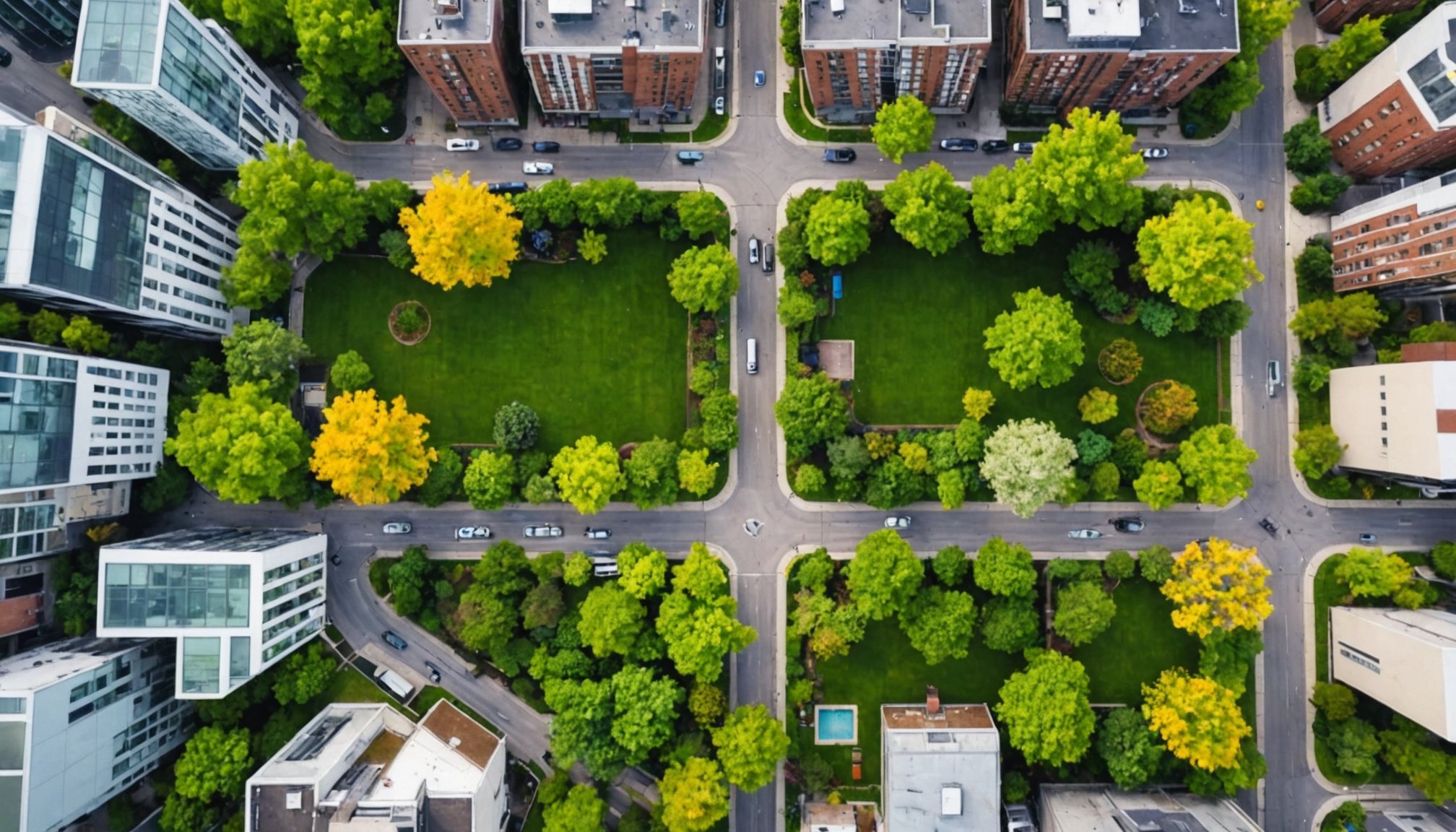Understanding Urban Green Spaces and Property Value
Urban green spaces are essential components of city landscapes, offering more than just aesthetic pleasure; they play a pivotal role in boosting property value. These spaces, which include parks, gardens, and natural reserves, enhance the livability of a community, making real estate more appealing to potential buyers. The presence of lush, green environments contributes to a sense of tranquility and recreational opportunities, leading to an increase in the desirability of nearby properties.
The correlation between these green spaces and real estate enhancement is supported by ample data. Studies have shown that homes within proximity to well-maintained parks often command a higher market value. This increase is not only due to the visual appeal and recreational possibilities but also because these areas often result in reduced noise and pollution, creating a more attractive setting for residents.
Also read : Unlocking Potential: Pioneering Approaches to Housing Development on UK’s Brownfield Sites
Analyzing various urban areas, we see a consistent trend: neighborhoods enriched with urban green spaces witness a marked uptick in their property values. For instance, properties bordering or nestled in these spaces typically enjoy faster appreciation rates compared to those in more congested urban environments. This effect encourages both homebuyers and investors to focus on regions with substantial green-space investments, securing both financial and lifestyle advantages.
Economic Impacts of Urban Green Spaces
Urban green spaces yield significant economic benefits, extending beyond mere property value growth. These spaces enhance local economies by increasing the desirability of nearby areas, thus aiding in property value appreciation. Homes close to well-maintained parks often see a marked increase in market value, heightening investment opportunities for prospective homeowners and investors alike.
In parallel : Unveiling the Financial Impact of Cultural Quarters on City Property Values
The presence of green areas significantly impacts local business revenues, attracting more visitors and customers. A lively and vibrant environment, encouraged by urban parks, can bolster economic activity in surrounding businesses. People seek out these areas for leisure, which can lead to increased foot traffic and business patronage in nearby shops and cafes.
Case studies reveal notable economic returns on green space investments. In many cities, urban green spaces contribute considerably to property value and bolster local real estate markets. For instance, neighbourhoods that integrate lush parks and gardens tend to experience accelerated economic development, with both commercial and residential properties benefiting. By fostering a positive economic environment, these urban oases offer compelling economic incentives, encouraging further investments and supporting thriving communities. Such financial return showcases the invaluable effects urban green spaces offer beyond their environmental and aesthetic contributions.
Design Principles for Effective Urban Green Spaces
Urban green spaces function as critical components of community health and environmental enhancement, necessitating thoughtful park design and urban planning. Effective green space design comprises various elements that contribute to their functionality and impact.
Key Components of Successful Green Space Design
To ensure community spaces are invigorating and accessible, incorporating features such as walking paths, seating areas, and native vegetation is vital. These elements enhance usability and engagement, encouraging frequent use by residents. Accessibility and safety must also be taken into account, ensuring easy access for all demographic groups, including those with disabilities.
Integration of Green Spaces into Urban Landscapes
Integrating green spaces into dense urban settings can be challenging but rewarding. Designs must consider limited space availability, requiring creative solutions, such as rooftop gardens and vertical green walls. Urban planners need to find harmony between built environments and natural elements, making green spaces an essential part of cityscapes.
Role of Community Engagement in Design Process
Community input plays a crucial role in crafting spaces that reflect local needs and values. Engaging the community during park planning ensures designs align with residents’ desires, resulting in greater usage and satisfaction. Collecting feedback through surveys and public consultations helps tailor green spaces to serve as true communal assets.
Expert Opinions and Insights
Understanding the perspectives of landscape architects and urban planners is crucial for creating impactful urban green spaces. These professionals possess diverse insights into strategies that enhance the functionality and appeal of community spaces. They emphasise creating environments that balance human activity with natural elements, fostering vibrant and resilient urban areas.
Landscape architects highlight the importance of integrating green spaces seamlessly into urban settings. Their designs focus on sustainability and climate adaptability, ensuring that spaces serve ecological purposes while offering recreational benefits. Utilising native vegetation and strategically placed greenery helps maintain biodiversity and improve urban air quality.
Urban planners contribute insights on regulatory frameworks and policies that support the development and maintenance of green spaces. Their role involves ensuring that city planning regulations accommodate and encourage the inclusion of vibrant green environments. By navigating these policies, urban planners advocate for spaces that enhance both public health and property values.
Expert analysis predicts future trends such as increased community engagement and technological integration in green space development. Incorporating smart technologies can optimise the management of these spaces, improving their accessibility and functionality. These insights guide the evolution of urban landscapes towards more sustainable and community-centred environments.
Sustainability and Community Impact
Exploring the sustainability of urban green spaces reveals their profound impact on community health and environmental benefits. These areas enhance urban living by promoting diverse ecosystems, improving air quality, and providing a sanctuary for residents.
Green spaces support community health by offering venues for outdoor activities, fostering physical activity, and reducing stress. The availability of such spaces encourages people to engage in exercise and leisure, thereby improving overall well-being and reducing health care costs related to sedentary lifestyles.
In ecological terms, urban parks contribute significantly to biodiversity. They serve as habitats for a variety of species, enriching urban areas with flora and fauna that might otherwise be absent. This biodiversity can improve urban air quality by filtering pollutants and producing oxygen, making cities more livable.
Environmental benefits further extend to microclimate regulation. Green spaces moderate urban temperatures, reducing the heat island effect and contributing to energy savings. Additionally, they play a crucial role in water management by aiding in stormwater absorption and reducing the risk of urban flooding.
The long-term sustainability of these green spaces necessitates thoughtful planning and maintenance strategies that align with urban development goals. By prioritising ecologically conscious designs, cities can ensure these benefits are preserved for future generations.
Recommendations for Developers and Urban Planners
In the realm of urban development strategies, finding effective ways to integrate urban green spaces remains pivotal. Developers and urban planners should adopt practical recommendations to weave green spaces seamlessly into evolving cityscapes. By prioritising the inclusion of parks and gardens, communities can enjoy enhanced aesthetics and resilience against urban challenges.
Green space integration should be considered from the inception of urban projects. Practical steps include identifying suitable locations for parks early in the design phase and ensuring these areas are accessible and well-connected within the urban fabric. By doing so, developments not only enhance property value but also promote community well-being.
Funding and maintaining urban green projects can pose challenges, yet strategies such as public-private partnerships and government grants prove beneficial. These approaches enable the financial viability and sustained management of green spaces, ensuring they continue to benefit communities over time.
Collaboration between developers and municipalities is essential. By adhering to best practices, such as engaging with local communities and seeking expert insights, projects can reflect community needs and environmental goals. This collaboration fosters urban environments where both nature and human activity thrive harmoniously.





